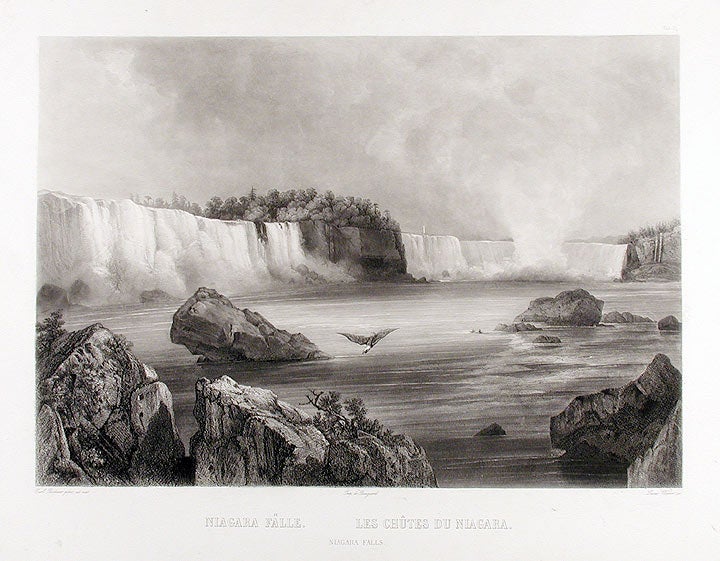BODMER, Karl (1809-1893)
Niagara Falls
[Tab. 39] Paris, Coblenz and London: [1839-1842]. Aquatint engraving by Lucas Weber after Bodmer, proof on india paper mounted, blindstamp, issue with no date at end of English imprint. Some light soiling, trimmed to within plate mark. Sheet size: 16 1/8 x 21 1/4 inches.
A rare India proof of one of the greatest landscape images to result from the Bodmer and Prince Maximilian's expedition to America's "Interior Parts." Bodmer saw the Falls for the first time on June 28, 1834 and was clearly inspired by the scenic splendor of one of the great natural wonders of the world. The travelers had reached the Falls towards the end of their expedition. Leaving Vincennes, Indiana, on about June 11th, they had traveled east, arriving on the Ohio opposite Louisville, Kentucky. Here they took ship for Cincinnati and Portsmouth following the route of the Ohio Canal along the Scioto River north to Cleveland on Lake Erie. From there they took a steamboat to Buffalo, New York. Niagara Falls remained a favorite subject of artists throughout the first half of the nineteenth century, but the present representation is arguably the finest to appear in print. Karl Bodmer's images show great versatility and technical virtuosity and give us a uniquely accomplished and detailed picture of a previously little understood (and soon to vanish) way of life. Swiss-born Bodmer was engaged by Prince Maximilian zu Wied-Neuwied (1782-1867) specifically to provide a record of his travels in North America, principally among the Plains Indians. David Dreidoppel (Prince Maximilian's servant and hunting companion) accompanied the men on their travels in North America, which lasted from 1832 to 1834. Well-armed with information and advice, the party finally left St. Louis, on the most important stage of their travels, aboard the steamer Yellow Stone on April 10, 1833. They proceeded up the treacherous Missouri River along the line of forts established by the American Fur Company. At Bellevue they encountered their first Indians, then went on to make contact with the Sioux tribe, learning of and recording their little known ceremonial dances and powerful pride and dignity. Transferring from the Yellow Stone to another steamer, the Assiniboin, they continued to Fort Clark, visiting there the Mandan, Mintari, and Crow tribes, then the Assiniboins at Fort Union, the main base of the American Fur Company. On a necessarily much smaller vessel they journeyed through the extraordinary geological scenery of that section of the Missouri to Fort Mackenzie in Montana, establishing a cautious friendship with the fearsome Blackfeet. From this, the westernmost point reached, it was considered too dangerous to continue and the return journey downstream began. The winter brought its own difficulties and discomforts, but Bodmer was still able to execute numerous studies of the villages, dances and especially the people, who were often both intrigued and delighted by his work. The portraits are particularly notable for their capturing of individual personalities, as well as for forming a primary account of what were to become virtually lost cultures.
Graff 4648; Howes M443a; Pilling 2521; Sabin 47014; Wagner-Camp 76:1.
Item #13860
Price: $950.00


